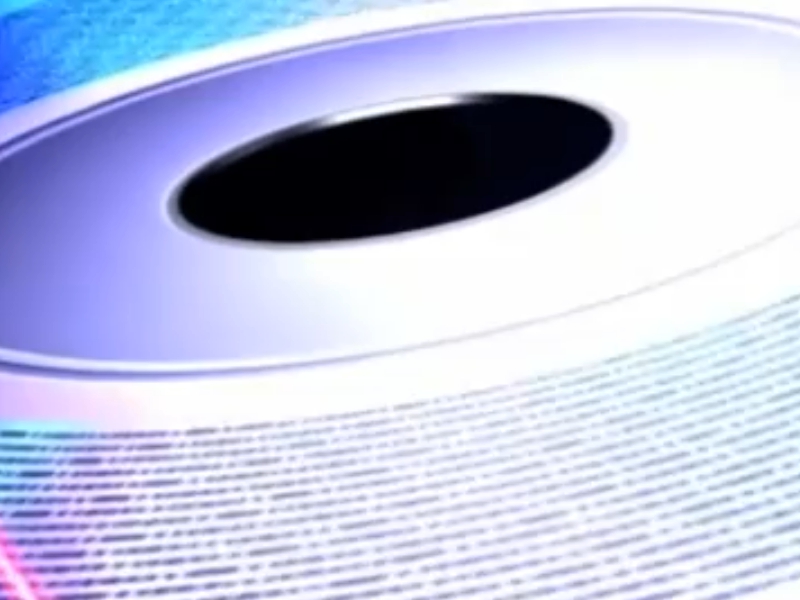Sony, Panasonic Developing 300GB+ Optical Disc Standard
Sony and Panasonic want a 300 GB optical disc by 2015.
On Monday Sony announced that it has agreed to work with Panasonic in developing a next-generation standard for an optical disc with at least 300 GB of storage by 2015.
The agreement arrives after both companies, who previously developed products based on the Blu-ray format, realized that optical discs will need larger capacities in years to come, especially as growth in the archive market continues to accelerate. Yet, why continue to use optical discs? Hard drives and solid-state drives have plenty of storage capacity, right? They're not long-term solutions.
"Optical disks have excellent properties to protect them against the environment, such as dust-resistance and water-resistance, and can also withstand changes in temperature and humidity when stored," the companies said in a statement. "They also allow inter-generational compatibility between different formats, ensuring that data can continue to be read even as formats evolve. This makes them a robust medium for long-term storage of content."
This standard will be based on technologies each developed separately, Sony said. Just last year, Sony commercialized a file-based archive system in its XDCAM series of professional broadcasting products which housed twelve 25 GB optical discs within a single, compact cartridge. In July, Panasonic launched the LB-DM9 series of optical disc storage devices which uses a magazine of twelve 100 GB optical discs. A maximum of 90 magazines can be stored in the LB-DM9, totaling 108 TB (the announcement claims 180 TB).
"In recent years, there has been an increasing need for archive capabilities, not only from video production industries, such as motion pictures and broadcasting, but also from cloud data centers that handle increasingly large volumes of data following the evolution in network services," Sony said. "By actively promoting the adoption of a new standard for next-generation high-capacity optical discs, they intend to offer solutions that preserve valuable data for future generations."
Sony and Panasonic will continue to hold discussions regarding the specifications and other items relating to the development of this new standard, the company said.
Get Tom's Hardware's best news and in-depth reviews, straight to your inbox.

Kevin Parrish has over a decade of experience as a writer, editor, and product tester. His work focused on computer hardware, networking equipment, smartphones, tablets, gaming consoles, and other internet-connected devices. His work has appeared in Tom's Hardware, Tom's Guide, Maximum PC, Digital Trends, Android Authority, How-To Geek, Lifewire, and others.
-
codo panasonic is already irrelevant and sony hasn't done anything of note in a long time. this a big step in the wrong directionReply -
wavetrex I wouldn't mind a 300GB disk, but if it's cost per gigabyte is higher than for HDDs (which is the case for today's BluRay), then no thank you.Reply -
DRosencraft As the article clearly states, this is mainly targeted towards archivists. 300 GB is an insane amount of space for a movie release, or a game, and is unseemly for an OS. Optical discs just make more sense for long-term storage (even if i do still prefer it for my games/OS/movies). This isn't so much a replacement for consumer Blu-Ray, as it is a replacement for niche and commercial Blu-Ray.Reply -
Daniel Revas Why is this such a big deal when this is out there? http://www.extremetech.com/computing/159245-new-optical-laser-can-increase-dvd-storage-up-to-one-petabyteReply
300GB? So what? -
hardcore_gamer This amount of storage will be required when 4K movies go mainstream. Not everyone will have internet connection fast enough to stream 4K. Therefore optical discs will be needed again.Reply -
ubercake Get with the program guys. We don't need your disks. Sony should have learned this with Blu-ray and lack of sales.Reply
Streaming is the way to go. If we want to store larger files, we can use internal or external HDDs/SSDs.
Internet speeds keep improving. By the time 4K is the standard HDTV format (5 years+?), our internet connections will be able to easily carry the 4K signal. -
kujospam Ubercake, I did not look up the specs. The question isn't can in 5 years can the AVERAGE internet connection handle ONE 4k stream. It's if it can handle AT LEAST THREE. The average house hold that uses streaming as a video service streams from more than one location. Wife watching her show, Husband watching his show, and a kid or two watching their shows. Wither that be from the TV, Computer, Tablet ( yes I know that won't require 4k), etc. It isn't uncommon in my house old for the older kids to be watching something on netflix or hulu, and my wife and I watching something else. Or even different items.Reply -
rwinches This in for near line hive storage. The NSA would be a good customer. A lot more cost effective than powered drives.Reply
If the LB-DM9 has advanced compression tech it might store a max of 180 TB on 108 TB of Disk. -
evo_7 Umm yeah uber, i think you're being short-sighted. I do prefer a USB/junk drive and cloud storage but sh*t I have to archive, this would be ideal given price point. To not have to dedicate a whole external/internal HD to projects and being able to more easily sort them versus relying on file-sorting and which HD would be another positive.Reply
That said, not everything in technology has to be based on how useful it is to "you" let alone no one can map out the net benefits to other technologies this may aid in developing.
